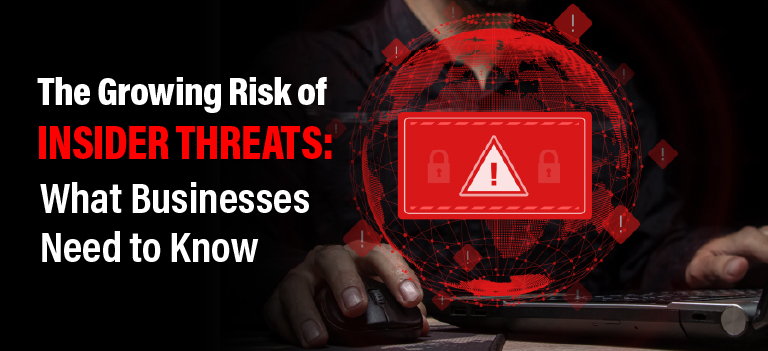There’s no surprise that cyber-attacks are becoming more prevalent and intense in today’s digitalized era. Organizations worldwide are trying to defend themselves against external attacks like phishing, ransomware, and Distributed Denial-of-Service (DDoS). However, businesses often fail to acknowledge the risks and vulnerabilities that lie within them, i.e., insider threats.
Organizations are now more vulnerable to insider threats than ever before. Insider threats mean attacks on an organization’s intellectual property, mainly to access or harm sensitive data unknowingly or unintentionally. These threats often originated from disgruntled or careless business associates or former employees with malicious intents. A recent survey found that 74% of respondents feel moderately to extremely vulnerable to insider threats. These figures show an eight percent rise in percentage compared to the previous survey.
Detecting and preventing insider threats have become a significant security challenge for organizations across all industries. It’s high time that companies find out ways to handle insider threats to protect their business integrity.
Why Are Insider Threats Rising?
A report finds that 67% of organizations experience over 40 incidents of insider threats annually. Due to the growing use of technologies, businesses must realize that they have become more vulnerable to insider threats. Companies store more data digitally without realizing the threat that dark data may expose them. In such circumstances, it has become easier for insiders to access and steal sensitive data and misuse them to fulfill their malicious intentions.
As the insider has legitimate access to the organization’s assets and sensitive information; thus, a data breach caused by an insider is more costly for an organization than one caused by an external attacker. These threats even pose a wide range of negative impacts, including the loss of crucial data, credential theft, operational disruption, and reputational damage.
Another reason insider attacks keep rising is because of the remote working culture. It’s challenging for organizations to monitor and track employee activities in a hybrid environment. This opens up a pathway for the insiders to compromise the business data or engage in malicious activity.
Moreover, businesses have always focused on preventing external threats like ransomware or software supply chain attacks and underestimate the risks insiders pose. Again, this enables the insiders to commit activities that harm the business data without being detected.
Tips To Improve Insider Threats Detection And Response
Detecting insider threats is one of the most challenging tasks businesses face today. It’s mainly because insider threats are quite misunderstood and assumed that they don’t exist. Fortunately, viable security tools and tips like the ones below allow the security teams to respond to insider threats faster:
- Automating the threat response process doesn’t add more burdens and instead makes the entire security infrastructure more effective.
- Enable continuous monitoring for weak credentials and password compromises with dynamic risk scores for each individual and service account.
- Centralize the user activities and behavior across all the data logs, endpoints, access, and authentication. Use this data to create a baseline of activity for every user, group, or device that helps detect suspicious activity.
Best Practices To Minimize Insider Threats Risks
Organizations need to implement some effective practices to protect themselves from insider threats. Here’s an insight into the measures that can help them in preventing the damage caused by an insider threat:
- CISO must conduct a full insider threat capability assessment to recognize and mark the existing gaps for improvement. The insight gathered from the evaluation helps to build an effective insider threat protection program that levels employees’ privacy with the organization’s security standard.
- As the Docker image security scan checks for misconfigurations and other risks that may lead to a security breach within a Docker-based application environment, similarly, the security teams must also deploy tools like the User and Entity Behavior Analytics Software (UEBA). These tools spot insider threats by detecting anomalous behavior and strengthen network security.
- With more employees working from home, proactive network monitoring of every business department, including the cloud environment, is crucial. In addition, be sure to encrypt the data traffic and back up critical data to prevent losing sensitive data.
- Organizations must have a dedicated threat-hunting team that proactively looks for hidden threats. They look for signs of hidden malware or patterns of suspicious activity that may result in identity theft or disruptions in operations.
- A zero-trust approach helps organizations manage insider threats efficiently and prevents critical business disruptions when employees work remotely or in a hybrid environment. This method starts with the assumption that your organization is compromised, and you need to authenticate every device, user, application, and dataset connected to the network.
- Employees act as the first line of defense for the organization’s security. They better understand the evolving threat landscape and ensure businesses take necessary steps to protect data. Therefore, the security teams must enforce strong cyberculture by encouraging the employees to use strong passwords and detect and respond to any suspicious activity or attack to the concerned department.
Final Thoughts
Insider threat attacks result in substantial losses for the organization. But with the right security tools, technology, and strategies, organizations can defend themselves against these threats. Businesses must foster a cybersecurity culture, use network security tools, and a zero-trust approach to prevent the risks of insider threats and strengthen their security infrastructure.


